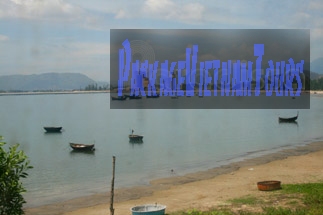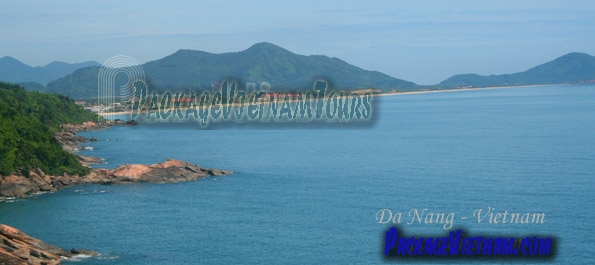
Da Nang
History
In the middle of the 16th century, when
Hoi An was a busy center of the south,
Da Nang was only a small port for goods in transit and ship repair. It gradually developed into a commercial port replacing Hoi An in the early 18th century, when European shipbuilding was improved and large deep draught vessels could easily enter Da Nang Bay.
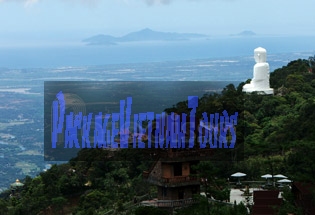
Ba Na Hill Station Da Nang
In 1835, after King Minh Mang ordered: “European vessels are not allowed to anchor to do trade at any harbours except for Han Port”, Da Nang became the largest commercial port in the central region. The local small-scale industries, including shipbuilding, preliminary processing of agricultural, forestry and fishery products, trade and services prospered accordingly.
The French colonists, after establishing their domination of the whole of Viet Nam in 1889, separated Da Nang from Quang Nam Province and renamed the city Tourane and under the control of the Governor General of Indochina.
In the early 20th century, Tourane was developed on a European model, which focused on social infrastructure and manufacture technology. Lots of economic activities took shape and thrived, such as agricultural production, small-scale industries, export product procesing (tea, food, beverages, ice, alcohol, fish sauce, dried fish), ship building and repair, and services. Together with Hai Phong and Sai Gon, Tourane became an important trading center of the country.

The mountains of Da Nang from Hai Van Pass
In 1950, French gave the authority over the city to the Bao Dai government. After the French's fall at Dien Bien Phu battle the French gave up fighting further. After the Geneva Accord, Da Nang belonged to southern area of the provisional demarcation line.
In March 1965, American marine units landed and started to set up a big military complex. The city was defined as a centrally governed city in 1967, and accordingly American troops and the Saigon government built up Da Nang into a political, military and cultural center of the 1st and 2nd tactical zones.
Military bases and such infrastructure as the airport, ports, warehouses, roads, public works, communication stations, and banks were constructed. Industries flourished, resulting in the substitution by industrial zones of handicraft workshops. For example, Hoa Khanh Industrial Zone was used for oxygen, acetylene and detergent production, grind and textiles industries. However, the devastating war made thousands of rural people flee in refugee camps. Urban slums appeared, social evils increased and production came to a standstill.
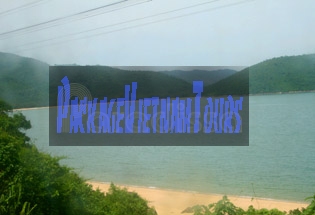
A wild beach of Da Nang near Hai Van Pass
In 1975, after reunification, Da Nang (temporarily under Quang Nam – Da Nang Province) began to overcome the war’s severe consequences. Regardless of difficulties, the city’s rehabilitation and development had some results, especially after the Reform in 1986.
On 6 July 1996, the tenth session of the 9th National Assembly of the Socialist Republic of Vietnam passed a Resolution separating Quang Nam – Danang Province into Quang Nam Province and Danang City, which was directly under the central government's administration. The new city of Da Nang consisted of the previous Da Nang, Hoa Vang Rural District and Hoang Sa Island District.
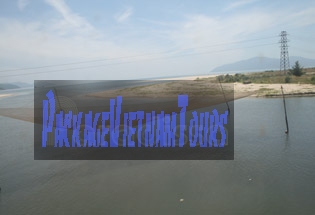
Idyllic scene outside of Da Nang City
Da Nang Major Tourist Attractions
The Cham Museums located on the riverside is dedicated to artifacts from the Indianized Champa Kindom of the Cham People. The kingdom experienced its heyday in the central area of Vietnam from the 2nd century A.D through the 15th century. The artifacts were brought here from
My Son - Cham Holy See by the French Archaeologists. The museum can be explored for 2 hours.
The Marble Mountains and Non Nuoc Beach and the Stone Carving Village
The Marble Mountains are a range of mountains bordered by the white sand Non Nuoc beaches. There are five mountain peaks which are said to represent the five earth elements. The sacred, lyric and poetical ambience of pagodas, grottoes, trees and white sand beaches combined with the murmuring sounds of the lapping waves make this spot a haven for tourists.
In ancient oriental philosophy; metal, wood, water, fire, earth were five elements that created the universe. Five is the paramount important number in life; it's the beginning number of all. Visiting the Marble Mountains is believed to bring the visitors and travellers the harmony of the universe.
Non Nuoc Beach characterized by blue ocean and fine white sand beaches was a major R&R base for US servicemen and war reporters during the war.
The complex of Marble Mountains, the Stone-Carving Village and Non Nuoc Beach can be explored for half a day; alternatively you can stay at one of the the luxurious 5 star resorts here.
Son Tra Peninsula run its way over 10km northeast of the Da Nang City into the sea. The highest peak is called Son Tra mountain which is over 693m above the sea. This is a nature reserve with diversity of flora and fauna. On the mountains, there're still more than 30sq. kilometers of natural forests.
From the top of the mountain, we can adore the breathtaking view of Da Nang City as well as the blue sea. Descending the mountains, we'll follow Suoi Da streams with crystal clear water which snake their ways through the forests to the sea. The green mountain cliffs and forests of Son Tra are ringed by the powdery white sand beaches.
Ba Na Hill Station located 40 kilometers southwest of Da Nang, Ba Na – Mount Chua is 1,487 meters high above the sea level. Ba Na offers a commanding view of the whole surroundings including Da Nang City, Son Tra Peak and the blue ocean. Ba Na was found and built into a hill station when the French was looking for a place to get away from the heat of Central Vietnam. There are many French-styled villas are left.
In Ba Na, there are four seasons in a day: spring in the morning, summer at noon, autumn in the afternoon, winter in the evening. While months from May to August are the hottest period (up to 38oC) in Central Viet Nam, temperature at Ba Na fluctuates from 17 to 20 degree Celsius, 22-25oC in maximum. It drops down to 15oC at night.
The Ba Na Nature Reserve has 544 sorts of high-altitude flora, 256 types of animals, in which there are 6 of flora and 44 of fauna listed in the Vietnamese Redbook (for precious species in Vietnam).
There are a number of sites of which some can be accessed by easy walk, some require hard trekking. It's recommended that you have boots while trekking here.
Ba Na can be done as a day trip from Da Nang or Hoi An; or can be spent for a relaxing getaway holiday.
Travel and Tours
Traveling in Da Nang, you can have a sighseeing tour of the city with the fantastic Cham Museum with artefacts from the Cham culture dated back from the 2nd century A.D or just hand around the exotic local markets.
You can travel to the Marble Mountains and get soaked in the Buddhist atmosphere. For the travelers who just want to relax, you may consider the Son Tra Peninsula or the Non Nuoc Beach where luxurious resorts are available. If you want to seek the cool climate, then better quit the city for Ba Na Hill Station, though accommodation here is not that luxurious.
Da Nang can be used as the base for exploring the ancient port town of Hoi An, the extinct Kingdom of Champa or My Lai Massacre Site.
Accommodation
There are many
hotels in Da Nang ranging from simple guest houses to luxurious 5 star hotels and spas. The luxurious hotels and resorts have very nice location. All resorts along the coastline from Son Tra Peninsula to Hoi An Port Town have nice white sand private beaches.
Getting there and away
You can travel to Da Nang from
Ha Noi,
Hue,
Nha Trang, or Sai Gon. There are many daily flights between Da Nang and Ha Noi/ Ho Chi Minh City which take 1h10 minutes. There are daily flights between Da Nang and Nha Trang - Cam Ranh however it takes 1h20 minutes due to aircraft type.
Da Nang is 30km from Hoi An Ancient Town. You can travel between these 2 spots by taxi, motorbike or by local bus. The drive takes 30 minutes.
Da Nang is 40km from Ba Na Hill Station. You need to have private car/motorbike to get to Ba Na from Da Nang.
Da Nang is 10km from Son Tra Peninsula. You can do a day trip from Da Nang to Son Tra.
Getting around
On foot: Da Nang City can be explored on foot since it's fairly small. Having a stroll around the riverside area is recommended. Still if you want to explore further, you may want to have a car or motorbike.
Xe Om (Motorbike taxi): There are many Xe Om drivers waiting for clients on many street corners. It's necessary you agree on the price before setting off.
Taxi: You can navigate around Da Nang and the surroundings by taxi. Price needs to be settled before commencing the trip. Otherwise the taxi needs to have a meter.
Vietnam Travel Guides
- Activities
- Arts & Entertainment
- Bac Kan
- Bac Lieu
- Bac Ninh
- Battlefields
- Ben Tre
- Buon Ma Thuot
- Ca Mau
- Can Tho
- Cao Bang
- Cat Ba Island
- Chau Doc
- Climate
- Cu Chi Tunnel
- Da Lat
- Da Nang
- Dangers & Annoyances
- Economy
- Embassies & Consulates for Vietnam
- Embassies & Consulates of Vietnam
- Festivals & Events
- Food & Drinks
- Geography
- Gia Lai




 Print
Print 